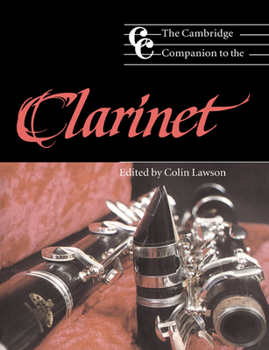The Cambridge Companion to the Clarinet
(Part of the Cambridge Companions to Music Series)
Select Format
Select Condition 
Book Overview
The Cambridge Companion to the Clarinet is a practical guide to the world of the clarinet. It offers students and performers a composite survey of the history and repertoire of the instrument from its origins to the present day, as well as practical guidance on teaching and performing. Special focus is made on the various members of the extensive clarinet family and specialist chapters provide advice on the mechanics of clarinet playing, the art of historical performance, contemporary techniques, and the clarinet in jazz. A chapter on the professional clarinettist introduces the world of the performing musician, while a survey of the clarinet on record provides the listener with a useful guide to the recording history of the instrument. Informed by the experience of distinguished performers and teachers, this book makes an essential and stimulating reference book for all clarinet enthusiasts.
Format:Paperback
Language:English
ISBN:0521476682
ISBN13:9780521476683
Release Date:February 1996
Publisher:Cambridge University Press
Length:260 Pages
Weight:1.06 lbs.
Dimensions:0.6" x 7.5" x 9.7"
Customer Reviews
3 ratings
The lore and allure of the clarinet - you should have this book!
Published by Thriftbooks.com User , 18 years ago
This is a very readable book, in short chapters, that covers a lot of ground in the world of clarinet playing. Each chapter is written by a different person and as a whole provides current thinking about the past, present, and future of the clarinetist's art. Do you enjoy both practical ideas of how to play as well as philosophical discussion? This is the book for you! As the Colin Lawson, editor says, this is more a generator of thought about many aspects of clarinet playing than it is a comprehensive study. There is plenty of information about the early history of the clarinet and the various types in the clarinet family. You will find good information about musical literature including the clarinet. The chapter by Tony Pay about mechanics of playing is probably the best as Mr. Pay raises many thoughtful points about just how we go about sounding our best as players and musicians. Equal to the historical chapters are the chapters about the current clarinet scene: jazz, recordings, and contemporary music. I highly recommend this book! John Gibson, JB Linear Music and author of Advanced Clarinet Technique; and Advanced Intonation Technique for Clarinets
Fun to read, with articles for experts as well as listeners
Published by Thriftbooks.com User , 20 years ago
This is an excellent book. But it is not primarily a guide for clarinetists who want general advice on subjects such as embouchure and reed selection. Jack Brymer's book, "Clarinet," is a guide for clarinetists. This is a book about the clarinet that anyone interested in the clarinet can appreciate. Still, it does include some expert advice on plenty of topics, including embouchure, tone, fingering, synchronization, and so forth. This is more of a survey of all the different clarinets (as well as their histories), clarinet repertoire, and modern trends. There are nice chapters on the clarinet family, including the high clarinets, the C clarinet, the basset horn, and the bass clarinet. The basset horn is famous for its huge range (four octaves!). But Georgina Dobree explains that it isn't easy to play. You need a soft reed, you have to be careful in all registers. And although it is easy to hit the high notes (especially if you have one of the smaller-bore ones), you may need alternate fingerings to play them in tune. Personally, I think the basset clarinet is a better instrument to learn, if you have the money to acquire one. Michael Harris discusses my favorite of the clarinets, the bass clarinet. I like it because its range extends far enough down so that one can play a wide variety of parts. Harris again explains that it isn't so tough to hit the highest notes on this instrument, but one has to choose a mouthpiece that lets you hit the next highest octave as well. Roger Heaton's chapter includes some good fingering choices for the highest notes. Then there are chapters on the clarinet repertoire, players and composers, clarinet recordings, the clarinet in jazz, the mechanics of playing the clarinet, and teaching the clarinet. Then we get some expert advice on how to play historical clarinets, from Colin Lawson. It's written in a style that is interesting for us non-professionals. Next is some explicit advice for the prospective professional clarinetist, from Nicholas Cox. The most fascinating chapter is by Roger Heaton, on the contemporary clarinet. That covers some topics such as high note fingerings, microtones, and circular breathing. You don't need to know much about the clarinet to enjoy this book. But to profit from the more expert advice, you need to play the clarinet fairly well already.
A great book
Published by Thriftbooks.com User , 24 years ago
I found this book to be the definitive guide for any clarinettist. All I can do is recommend it as the best resource for all. It gives great advice on all aspects of clarinet playing from reed selection to achieving a great embouchure. Buy it !





